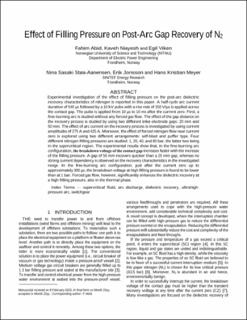| dc.contributor.author | Abid, Fahim | |
| dc.contributor.author | Niayesh, Kaveh | |
| dc.contributor.author | Viken, Egil | |
| dc.contributor.author | Støa-Aanensen, Nina Sasaki | |
| dc.contributor.author | Jonsson, Erik | |
| dc.contributor.author | Meyer, Hans Kristian Hygen | |
| dc.date.accessioned | 2021-09-06T11:01:38Z | |
| dc.date.available | 2021-09-06T11:01:38Z | |
| dc.date.created | 2020-08-06T13:09:35Z | |
| dc.date.issued | 2020 | |
| dc.identifier.citation | IEEE transactions on dielectrics and electrical insulation. 2020, 27 (4), 1339-1347. | en_US |
| dc.identifier.issn | 1070-9878 | |
| dc.identifier.uri | https://hdl.handle.net/11250/2773725 | |
| dc.description.abstract | Experimental investigation of the effect of filling pressure on the post-arc dielectric recovery characteristics of nitrogen is reported in this paper. A half-cycle arc current duration of 540 μs followed by a 10 kV pulse with a rise rate of 150 V/μs is applied across the contact gap. The pulse is applied from 10 μs to 10 ms after the current zero. First, a free-burning arc is studied without any forced gas flow. The effect of the gap distance on the recovery process is studied by using two different inter-electrode gaps: 20 mm and 50 mm. The effect of arc current on the recovery process is investigated by using current amplitudes of 275 A and 425 A. Moreover, the effect of forced nitrogen flow near current zero is explored using two different arrangements: self-blast and puffer type. Four different nitrogen filling pressures are studied: 1, 20, 40, and 80 bar, the latter two being in the supercritical region. The experimental results show that, in the free-burning arc configuration, the breakdown voltage of the contact gap increases faster with the increase of the filling pressure. A gap of 50 mm recovers quicker than a 20 mm gap, whereas no strong current dependency is observed on the recovery characteristics in the investigated range. In the free-burning arc configuration, just after the current zero up to approximately 300 μs, the breakdown voltage at high filling pressure is found to be lower than at 1 bar. Forced gas flow, however, significantly enhances the dielectric recovery at a high filling pressure, also in the thermal phase. | en_US |
| dc.language.iso | eng | en_US |
| dc.publisher | Institute of Electrical and Electronics Engineers (IEEE) | en_US |
| dc.title | Effect of Filling Pressure on Post-Arc Gap Recovery of N2 | en_US |
| dc.type | Peer reviewed | en_US |
| dc.type | Journal article | en_US |
| dc.description.version | acceptedVersion | en_US |
| dc.source.pagenumber | 1339-1347 | en_US |
| dc.source.volume | 27 | en_US |
| dc.source.journal | IEEE transactions on dielectrics and electrical insulation | en_US |
| dc.source.issue | 4 | en_US |
| dc.identifier.doi | 10.1109/TDEI.2020.008844 | |
| dc.identifier.cristin | 1822021 | |
| dc.description.localcode | © 2020 IEEE. Personal use of this material is permitted. Permission from IEEE must be obtained for all other uses, in any current or future media, including reprinting/republishing this material for advertising or promotional purposes, creating new collective works, for resale or redistribution to servers or lists, or reuse of any copyrighted component of this work in other works. | en_US |
| cristin.ispublished | true | |
| cristin.fulltext | preprint | |
| cristin.fulltext | postprint | |
| cristin.qualitycode | 1 | |
